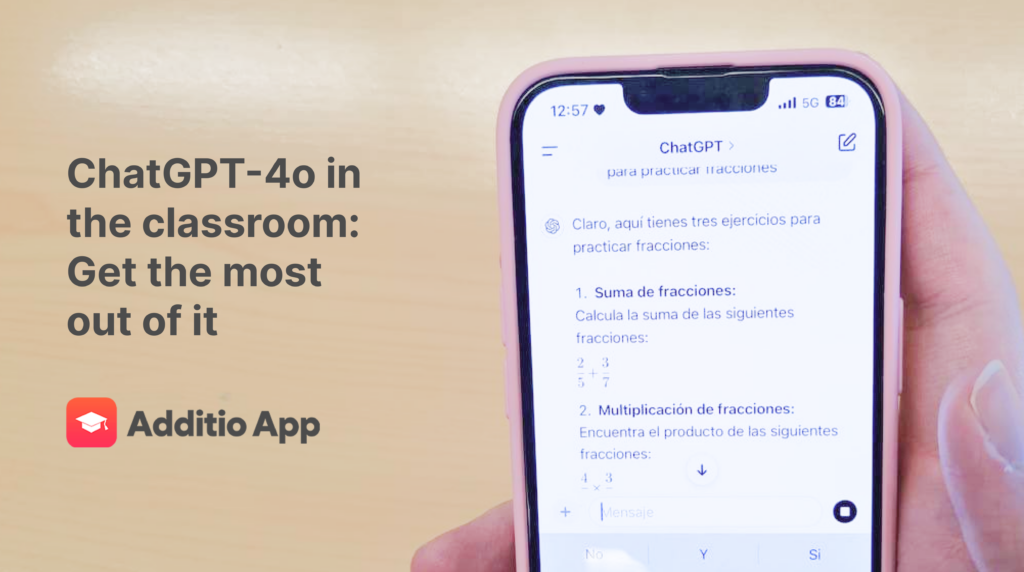There’s been a lot of buzz on the internet recently about the rollout of ChatGPT-4o, a new version of the well-known ChatGPT that promises to change the way we interact with AI. This new version has caused quite a sensation because, for free, it offers many improvements that will also assist us in our teaching.
In this post, we will explore the innovations of this new version of ChatGPT, which replaces ChatGPT 3.5, and we will see potential applications of ChatGPT-4o in the classroom, with real-life examples.
If you’re interested in artificial intelligence and generative AI, you shouldn’t miss these blog posts we’ve made: How to Use OpenAI’s ChatGPT for Education, AI Tools that Will Serve You for Class, or Educational Prompts that Will Help You Integrate AI in the Classroom.
Are you ready to see everything that’s coming? Keep reading!

What’s new with ChatGPT-4o: Why everyone is talking about it?
At the beginning of May 2024, OpenAI, the developer of ChatGPT, introduced the new version of the chatbot, called ChatGPT-4o (the “o” stands for “omni,” meaning it covers everything). It didn’t take long for users to see this new version in their accounts.
But why is this new version so revolutionary? We’ll tell you all the details below:
- It is a multimodal version that works with video, images, files, audio, and text. This means the AI can perform simultaneous translations, work with images and videos, and more.
- You can interrupt the chatbot to stop the explanation or to reformulate the request.
- In the web version, you can attach files to work with, such as image files, Word documents, Excel documents, etc. This allows for transcriptions, summaries, descriptions, etc.
- In the mobile version, the tool supports inputs from images, camera, files, audio, and real-time voice interaction, which is the most revolutionary feature OpenAI has announced.
- The AI can detect emotions and tones of voice.
- This model can solve more complex maths problems, thanks to its multimodal capabilities.
- It works as a real-time visual assistant, as it can identify objects through the camera, interact with the environment, and read text, among other functions.
- It is also capable of generating images from written prompts, using GPTs from the community or created by ChatGPT, such as Dall-e, which can now be used within the tool itself. However, it seems that for now, you will need the paid version to access these kinds of extras.
Although you can now perform all these actions with the free version, it does have some limitations, meaning you can only make a limited number of requests using ChatGPT-4o per hour. Even so, you can make the most of ChatGPT-4o in the classroom, and we will see how next.
Possible uses of ChatGPT-4o in the classroom to support teaching
Now that we’ve seen all the possibilities that open up with this new model, let’s see how we can get the most out of it to support our teaching.
One important thing to note is that responsible use of artificial intelligence, including chatbots like ChatGPT, is essential. These models are not perfect, and responses should always be validated. It’s also crucial to monitor the data you provide and the use you allow.
However, these new releases can be beneficial in saving time and resources. Let’s see how:
- Solving maths problems of varying complexity: The new model can solve maths problems of varying complexity, whether from text, images, video… The really interesting thing about this improvement is that it can guide students on how to find the solution to the problem, but without directly giving the answer. This greatly helps students and has a very positive impact on their learning.
In Additio App, you can indicate if your students can use this type of help by sending them instructions through the communication platform to perform the exercises at home, for example.
They demonstrated this ability to solve complex maths problems live from OpenAI alongside Khan Academy, as you can see in this video:
2. Support for visual or auditory disabilities: Being multimodal, the tool can provide support for different disabilities, especially visual and auditory impairments.
For visual impairments, ChatGPT-4o allows for voice interaction, so students can use this tool if needed for a class activity. Additionally, it can describe images or read text, which will assist students in completing tasks.
Regarding auditory impairments, the tool can communicate via text and can transcribe or subtitle videos, greatly aiding students with hearing disabilities.
You can indicate all this in the Diversity Care section of Additio App, to take into account for your classes and facilitate the inclusion of students with disabilities or special educational needs.
In this example, we see how the tool summarises a YouTube video, which helps your students with hearing impairments:
3. Language learning: Thanks to voice interaction, ChatGPT-4o can be used in the classroom to simulate conversations in the foreign language your students are studying. In this way, students will converse with the tool, which can also offer them real-time feedback on their performance and make improvement proposals.
You can also rely on GPTs created by the community to facilitate language learning, such as the GPT “Language Teacher – Ms. Smith”, which becomes a personal tutor for learning over 20 languages.
- Image identification: Thanks to the ability to share images with the tool, it can identify them, detailing what is observed. This can be useful in History class (to identify historical events), Art History (to identify artistic movements), Biology (to identify animals, plants, etc.), or any other subject.
And you, are you going to try ChatGPT-4o in the classroom to boost your teaching and your students’ learning?
As you have already seen, although it has certain limitations in its use, ChatGPT-4o offers a lot of possibilities that can be very useful for your day-to-day and for improving your students’ teaching. Have you tried it yet?
What would you think if we conducted a live webinar together to test these new ChatGPT-4o functionalities for the classroom and see how to further leverage Additio App to enhance the results achieved? Tell us on social media: Facebook, Twitter, Instagram and Youtube.
Additio App, the school management, assessment, and communication platform that helps you put students at the centre of learning.
With Additio App, you can conduct competency-based assessments that put students at the centre of learning, keeping them informed about their progress and helping them identify areas for improvement and strengths.
More than 150 features accompany you to improve your teaching and student learning. You can try the tool for free with the Additio Starter plan, which gives you access to most features, and verify that the platform truly meets your needs.
See you soon!





